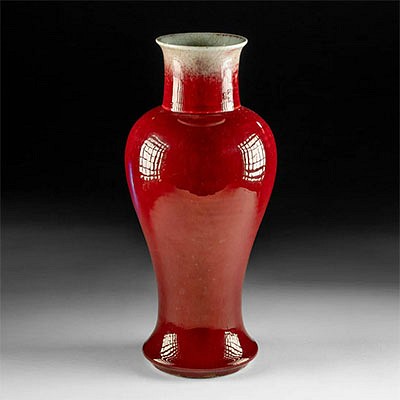Exhibited / Published Roman Mosaic Panel, Geometric
Lot 51
About Seller
Artemis Fine Arts
686 S Taylor Ave, Ste 106
Louisville, CO 80027
United States
Selling antiquities, ancient and ethnographic art online since 1993, Artemis Gallery specializes in Classical Antiquities (Egyptian, Greek, Roman, Near Eastern), Asian, Pre-Columbian, African / Tribal / Oceanographic art. Our extensive inventory includes pottery, stone, metal, wood, glass and textil...Read more
Estimate:
$8,000 - $12,000
Absentee vs Live bid
Two ways to bid:
- Leave a max absentee bid and the platform will bid on your behalf up to your maximum bid during the live auction.
- Bid live during the auction and your bids will be submitted real-time to the auctioneer.
Bid Increments
| Price | Bid Increment |
|---|---|
| $0 | $25 |
| $300 | $50 |
| $1,000 | $100 |
| $2,000 | $250 |
| $5,000 | $500 |
| $10,000 | $1,000 |
| $20,000 | $2,500 |
| $50,000 | $5,000 |
| $100,000 | $10,000 |
| $200,000 | $20,000 |
About Auction
By Artemis Fine Arts
May 11, 2023
Set Reminder
2023-05-11 10:00:00
2023-05-11 10:00:00
America/New_York
Bidsquare
Bidsquare : Fine Antiquities, Asian, Pre-Columbian, Ethnographic Art
https://www.bidsquare.com/auctions/artemis-gallery/fine-antiquities-asian-pre-columbian-ethnographic-art-12771
Classical antiquities, ancient and ethnographic art from cultures encompassing the globe. Artemis Fine Arts info@artemisgallery.com
Classical antiquities, ancient and ethnographic art from cultures encompassing the globe. Artemis Fine Arts info@artemisgallery.com
- Lot Description
**Originally Listed At $4500**
Roman, late Imperial Period, Eastern Empire, modern-day Syria, ca. 4th to 5th century CE. A mesmerizing mosaic depicting a 2-stranded guilloche band framed by a T-shaped meander pattern and flanked by 2 undulating lines, all delineated in hundreds of vibrant stone tesserae. This mosaic may have been part of border decorations of larger figurative mosaic floors that once graced a house or church, of may have been part of smaller mosaic pavements adorning a hallway or walkway in a town or country house. This example is accompanied by a modern metal table frame allowing it to serve as a tabletop. Sure to astound all your houseguests, bringing all the opulence of the Roman Empire to your very own home! Size of mosaic: 44.5" L x 22.5" W (113 cm x 57.2 cm); of matrix: 46.25" L x 24" W (117.5 cm x 61 cm)
Quite popular throughout the Greco-Roman world, the interlacing patterns seen in this example are likely Solomon's knot variants. The Solomon's knot is named for the biblical monarch Solomon who was known for his wisdom. In the study of ancient mosaics, the Solomon's knot is also known as a "guilloche knot" or a "duplex knot."
Mosaics (opus tesellatum) are some of our enduring images from the Roman world, appreciated not only for their aesthetic beauty, but also because they reveal what Romans chose to depict and see every day decorating their private and public spaces. In the Roman province of Syria, which encompassed most of the ancient Near East/Levant, mosaics seem to have developed as a common art form relatively late, with most finds coming from the 3rd century CE or later. Syria was one of Rome's wealthiest provinces, but it was also far removed from Rome itself and Roman culture was overlaid on enduring cultural traditions from Hellenistic Greece and the great civilizations that came before it. Antioch-on-the-Orontes (modern day Antakya, Turkey), was the capital of northern Roman Syria, and its excavations in the 1930s revealed more than three hundred mosaic pavements.
This piece was exhibited at the Hallie Ford Museum of Art at Willamette University, Salem, Oregon as part of the "Ancient Mosaics: Selections from the Richard Brockway Collection" exhibition that took place from September 26th to December 23rd, 2009. It was also published in the exhibition's brochure of the same name as Figure 7 on page 10.
Please note: items from Syria are not eligible for international shipping due to the US embargo on Syria.
This item is heavy/oversized and will require 3rd party shipping. Please inquire about shipping cost prior to bidding.
Provenance: private Vero Beach, Florida, USA collection, acquired before 2003
All items legal to buy/sell under U.S. Statute covering cultural patrimony Code 2600, CHAPTER 14, and are guaranteed to be as described or your money back.
A Certificate of Authenticity will accompany all winning bids.
We ship worldwide and handle all shipping in-house for your convenience.
#177250Usable as a tabletop with accompanying metal table frame. Fragment of a larger piece with some chipping, fissures, and minor losses to some tesserae, but otherwise mostly intact with nice preservation of decorative program and liberal remaining pigments.Condition
- Shipping Info
-
All shipping is handled in-house for your convenience. Your invoice from Artemis Gallery will include shipping calculation instructions. If in doubt, please inquire BEFORE bidding for estimated shipping costs for individual items. In most cases Artemis Gallery cannot ship to Australia and Germany, please inquire before bidding.
-
- Buyer's Premium



 EUR
EUR CAD
CAD AUD
AUD GBP
GBP MXN
MXN HKD
HKD CNY
CNY MYR
MYR SEK
SEK SGD
SGD CHF
CHF THB
THB















